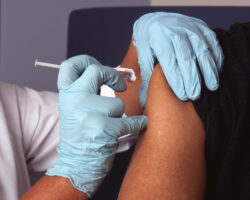Rising Cancer Rates in Young Adults Shake Medical Community
This article examines the worrying rise in cancer rates among adolescents and young adults (AYAs), a demographic constituting approximately 4% of all US cancer diagnoses. We delve into the implications for the medical community, discussing the essential role of specialized care and treatment planning. As this health crisis escalates, understanding these alarming statistics and the importance of expert oncological support is paramount in addressing this critical health issue and improving patient outcomes.

Key Takeaways
- The incidence rates of cancer among adolescents and young adults have been increasing on average 0.3% each year from 2010 to 2019.
- The most common cancers in this age group include breast cancer, thyroid cancer, testicular cancer, melanoma, and brain and other central nervous system tumors.
- Survival rates for cancer in adolescents and young adults have been increasing, with an overall average death rate decrease of 0.9% each year from 2011 to 2020.
- It is important for young adults with cancer to find an oncologist specialized in treating their specific type of cancer, and getting a second opinion can be helpful, especially for complicated medical decisions or rare cancers.
The Current State of Cancer Among Young Adults
In the United States, approximately 85,980 adolescents and young adults (AYAs) between the ages of 15 and 39 are projected to be diagnosed with cancer in 2023, representing about 4% of all cancer diagnoses. Analysis of age-specific cancer rates reveals that the incidence is not evenly distributed across this age group. The rates are relatively low in early adolescence, then increase significantly during the late teenage years and early adulthood. Notably, there are gender differences in cancer rates. While AYAs are generally affected by the same types of cancers, the relative frequencies differ by sex. Testicular cancer and thyroid cancer are more common in males, while breast cancer and cervical cancer are more prevalent in females. Understanding these trends is crucial for effective cancer prevention and control strategies.
A Closer Look at Cancer Statistics in Adolescents
As we delve into the specific cancer statistics in adolescents, it becomes increasingly evident that the rising numbers are indeed a cause for concern and warrant further investigation. Age specific cancer rates indicate a consistent increase, with a 0.3% annual rise among adolescents and young adults from 2010 to 2019. Furthermore, gender differences in young adult cancer rates are noticeable, with females most commonly diagnosed with breast and thyroid cancer, and males with testicular and colorectal cancer. The survival rates, however, are promising, with an overall relative survival rate of 86%. The upward trend in adolescent cancer rates underscores the need for ongoing research and targeted interventions to further improve the prognosis for this age group.
Understanding the Common Types of Cancer in Young Adults
Several forms of cancer are commonly diagnosed in young adults, with the top five being breast cancer, thyroid cancer, testicular cancer, melanoma, and brain and other central nervous system tumors. These types of cancer have been linked to the impact of lifestyle factors on cancer risk among young adults. Factors such as diet, physical activity, and exposure to harmful substances can increase a person's risk of developing these cancers. However, the medical community is responding with emerging trends in cancer treatment for young adults, including targeted therapies and immunotherapies. These new treatments are designed to attack specific cancer cells, potentially improving outcomes and reducing side effects, offering hope to young adults facing a cancer diagnosis.
Age-Specific Cancer Rates: A Detailed Analysis
While the overall incidence of cancer among adolescents and young adults has been on the rise, it is crucial to delve into the age-specific cancer rates to better understand this alarming trend. A detailed analysis shows significant gender disparities in young adult cancer rates. For instance, breast and thyroid cancers are more prevalent in females, while testicular cancer is common in males. Furthermore, lifestyle factors greatly impact young adult cancer rates. Unhealthy eating habits, lack of physical activity, and substance abuse, such as smoking and excessive alcohol intake, are linked to an increased risk of certain cancers. By understanding these patterns and influences, we can foster more targeted prevention strategies and early detection methods.
Gender Differences in Young Adult Cancer Rates
We must now turn our attention to the distinct variations in cancer rates among young males and females, revealing critical gender differences that could potentially inform more effective and personalized treatment approaches. A growing body of research underscores the gender disparities in young adult cancer rates, with patterns showing certain types of cancers being more prevalent in one sex over the other. For instance, testicular cancer is more common in males, while breast and thyroid cancers are more prevalent in females. Factors such as genetics, hormonal differences, and even the impact of lifestyle factors on young adult cancer rates, including diet, exercise, and exposure to environmental carcinogens, could be contributing to these disparities. Understanding these gender-based variations is crucial for developing targeted prevention and treatment strategies.
The Soaring Incidence of Breast Cancer in Young Women
Although the overall cancer rates among young adults are alarming, the particularly steep rise in the incidence of breast cancer in young women demands urgent attention and comprehensive investigation. This surge not only raises concerns about the underlying causes but also underscores the need for improved breast cancer awareness and early detection strategies. Promoting awareness can empower women with knowledge about risk factors, symptoms, and the importance of regular self-examinations. Meanwhile, optimizing early detection strategies, such as mammography and genetic testing, can lead to timely diagnoses and prompt treatments. As the medical community grapples with this worrying trend, an intensified focus on these areas could contribute significantly to mitigating the impact of this disease on young women's lives.
Unraveling the Mystery of Thyroid Cancer in Young Adults
Given that thyroid cancer is increasingly prevalent among young adults, it is crucial to delve deeper into its complexities and uncover both its underlying causes and effective measures for early detection and treatment. Current thyroid cancer research indicates a multifactorial cause including environmental factors, genetic predisposition, and lifestyle habits. An alarming concern is the potential impact on fertility, particularly in women. Some treatments may impair fertility, necessitating a delicate balance between managing the disease and preserving reproductive potential. Early detection through regular check-ups and self-examinations is advocated, as it can significantly increase treatment success rates. As we continue to unravel this mystery, it is imperative that we keep pushing the boundaries of our understanding towards improved treatment protocols and patient outcomes.
Addressing the Rise of Testicular Cancer in Young Men
Surprisingly, testicular cancer has been increasingly prevalent among young men, and it is crucial that the medical community intensify efforts for early detection, comprehensive treatment, and public awareness. Addressing treatment options for this disease involves a variety of methods, including surgery, chemotherapy, and radiation therapy. It's essential to tailor these options to each patient's unique circumstances, considering factors such as the cancer stage and the patient's overall health. The psychological impact of a testicular cancer diagnosis is significant, affecting a young man's self-esteem, mental health, and relationships. Thus, support systems and mental health services are indispensable components of treatment. Through combined efforts, we can mitigate the rise of this disease and the toll it takes on young men's lives.
The Unexpected Rise of Melanoma in Youth
Amid the spectrum of cancer types afflicting young adults, there has been a startling increase in the incidence of melanoma. This unexpected rise is jolting the medical community into action, prompting the implementation of enhanced prevention strategies. These include increasing public awareness about the dangers of unprotected sun exposure and the importance of regular skin checks. Despite these efforts, the impact on mental health is substantial. The diagnosis often triggers anxiety and depression, exacerbating an already distressing situation. Furthermore, the prospect of living with a potentially deadly disease at such a young age can be psychologically devastating. Therefore, addressing mental health issues should be an integral part of the care provided to young melanoma patients.
A Glimpse at Survival Rates for Young Adult Cancer Patients
The survival rates for cancer among young adults, a critical metric in the field of oncology, provide insights into the effectiveness of current therapeutic strategies and the prognosis for patients in this age group. With advancements in treatment methods, survival rates have seen a positive trend. However, the journey post-diagnosis is often a rollercoaster, impacting not only the physical but also the mental health of the patients. The psychological stress resulting from a cancer diagnosis can lead to depression, anxiety, and other mental health disorders. It is, therefore, imperative that medical professionals address these issues alongside the physical treatment. In conclusion, while survival rates are improving, a comprehensive approach that includes mental health care is vital to improving overall patient outcomes.
The Journey After Cancer Diagnosis: Choosing the Right Oncologist
Navigating through the complexities of a cancer diagnosis, young adults face the crucial task of choosing an oncologist whose expertise aligns with their specific type of cancer. The oncologist will not only guide the technical aspects of treatment but can also lend crucial support in navigating the impact of cancer on mental health. The role of support groups in cancer treatment also becomes essential as they provide a platform for sharing experiences, reducing feelings of isolation and offering practical advice. Selecting the right oncologist, therefore, is not just about medical expertise, but also about finding a healthcare provider who understands the unique challenges young adults face, including the psychological strain that accompanies a cancer diagnosis.
Role of Pediatric Oncologists in Treating Young Adults
In the realm of rising cancer rates among young adults, a significant role is often played by pediatric oncologists who are uniquely equipped to treat certain types of cancers predominantly found in this age group. These specialists bridge the gap between pediatric and adult oncology, offering a unique perspective and expertise in treating young adults. The role of pediatric oncologists is not limited to diagnosis and treatment but extends to long-term follow-up care, ensuring overall wellbeing. They are pivotal in implementing an interdisciplinary approach in young adult cancer treatment, collaborating with a team of professionals such as psychologists, dieticians, and social workers. This approach is crucial to address the complex physical, psychological, and social challenges young adults face during cancer treatment.
Importance of Second Opinions in Cancer Treatment Decisions
Given the complexity and potential severity of a cancer diagnosis, patients are strongly encouraged to seek out a second opinion to ensure they are making well-informed decisions about their treatment options. The role of second opinions in cancer treatment decisions cannot be overstated. It not only provides a chance to confirm the diagnosis but also to explore a variety of treatment strategies that may not have been initially considered. The benefits of seeking a second opinion in cancer care include gaining clarity about the disease and its trajectory, understanding all available treatment options, and feeling more confident about the chosen treatment path. In light of the rising cancer rates in young adults, the need for second opinions becomes even more critical to ensure the best possible outcomes.
How Nci-Designated Cancer Centers Are Addressing the Issue
We are now turning our attention to the proactive measures that NCI-Designated Cancer Centers are taking to address the escalating issue of cancer rates in young adults. These centers are at the forefront of advancements in cancer research and treatment, focusing on providing individualized, innovative therapies to combat cancer's prevalence. These institutions are also cognizant of the impact of cancer on mental health. Consequently, they are investing in comprehensive care programs that incorporate psychological support, acknowledging that the fight against cancer is not just physical, but mental as well. As the cancer rates continue to increase, these centers are intensifying their efforts to improve treatment options, enhance survivorship, and ultimately, lessen the burden of cancer on the younger population.
The Future of Cancer Treatment in the Wake of Rising Rates
The escalating rates of cancer diagnoses among young adults necessitate a comprehensive re-evaluation of the current strategies and future plans for cancer treatment. The impact of rising cancer rates on healthcare systems is profound, with a growing demand for specialized services and resources. The future of treatment lies in personalized, patient-centered care, with advancements in targeted therapies for young adult cancer patients at its core. These advancements, which include precision medicine and immunotherapy, can significantly improve outcomes and reduce side-effects. However, implementing these changes requires a systemic shift in our approach to healthcare. We must foster greater collaboration between researchers, clinicians, and patients, and invest in necessary infrastructure to support this new paradigm of cancer treatment.
Frequently Asked Questions
What Are the Potential Causes for the Rising Incidence of Cancer in Young Adults?
The increasing incidence of cancer in young adults may be attributed to various factors. Genetic predisposition, lifestyle choices, and environmental exposures could contribute to this rise. Additionally, instances of cancer misdiagnosis may lead to delayed or improper treatment, further compounding the issue. Lastly, disparities in treatment accessibility, particularly among disadvantaged populations, can impede early detection and effective management, potentially exacerbating cancer rates.
How Does Lifestyle and Environmental Factors Contribute to the Increasing Rates of Cancer in Adolescents and Young Adults?
Lifestyle and environmental factors significantly contribute to increasing cancer rates in young adults. Dietary influences, involving high consumption of processed and sugary foods, are linked to obesity and subsequently cancer. Moreover, digital exposure from electronic devices may also have potential carcinogenic effects. Further research is required to fully understand these relationships and develop effective prevention strategies.
Is There a Genetic Component to the Higher Rates of Certain Types of Cancer in Young Adults?
There is indeed a genetic component to the higher rates of certain types of cancer in young adults. Certain inherited genetic mutations can significantly increase an individual's risk of developing cancer. Genetic counseling can provide crucial insight into this inherited risk, enabling early detection and preventative measures. Thus, understanding one's genetic predisposition is essential in managing and potentially mitigating the risk of cancer, particularly in young adults.
How Is the Mental Health of Young Adult Cancer Patients Being Addressed During Treatment?
The mental health of young adult cancer patients is addressed through psycho-oncology support, an interdisciplinary approach focusing on psychological, social, and behavioral aspects of cancer. This includes counseling, group therapy, and stress management techniques. Art therapy benefits are also recognized, helping patients express feelings that may be difficult to verbalize, reducing stress and improving self-esteem. These interventions aim to enhance patients' mental wellbeing during their cancer treatment journey.
What Role Does Early Detection and Preventative Measures Play in Combating the Rising Rates of Cancer in Young Adults?
Early detection through increased screening accessibility plays a crucial role in managing rising cancer rates in young adults. It enables timely intervention, potentially improving prognosis and enhancing survival rates. Additionally, treatment innovations, such as targeted therapies and immunotherapy, provide new avenues for combating cancer. Preventative measures, including lifestyle modifications and vaccinations, further contribute to reducing cancer risk. Therefore, a comprehensive approach combining early detection and prevention is instrumental in addressing this issue.
Conclusion
The escalating incidence of cancer in adolescents and young adults necessitates urgent attention and specialized care. The medical community must foster collaboration, innovation, and patient-centered care to address this alarming issue. The selection of a specialized oncologist and considering second opinions can significantly impact patient outcomes. With the support of dedicated cancer centers, a future with improved survival rates and lower cancer incidences can be envisioned. The fight against cancer in young adults remains a critical public health concern.

This post has been generated by AI and was not reviewed by editors. This is Not legal advice. Please consult with an attorney.




